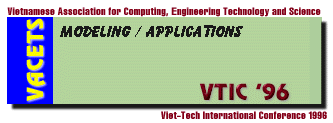
A DISCRETE-TIME MODEL FOR CODED DENSE WDM NETWORKS EMPLOYING FABRY-PEROT FILTERS
Tri T. Ha and John P. Powers
Department of Electrical and Computer Engineering
Code EC/HA
Naval Postgraduate School
Monterey, CA 93943 USA
Abstract
We present a novel discrete-time model to evaluate the capacity, power
penalty/coding gain and bit error probability of dense WDM networks
employing OOK modulation with direct detection and Fabry-Perot filters as
channel selector. Reed-Solomon error correcting codes and concatenated
Reed-Solomon/Reed-Solomon codes are employed to pack the optical channels.
The discrete-time model utilizes the trapezoidal expression together with
signal samples obtained at the Nyquist rate equal to twice the Fabry-Perot
spectral range.
COMPARISON OF LOWER BOUNDS IN DIRECTION OF ARRIVAL ESTIMATION
Hung Nguyen
Mountain Technology Inc.
5243 Braywood Drive
Centreville, VA 22020
E-Mail: [email protected]
Abstract
The performance of nonlinear estimators exhibits an SNR
threshold behavior above which the estimator mean square error
performance is small and can be closely characterized by the
Cramer-Rao lower bound. Below the threshold SNR, the MSE
performance is large and can exceed the CRLB by a large factor,
implying that the CRLB is an overly optimistic lower bound to
use. Thus, improved lower bounds can be used to analyze the
performance of direction of arrival (DOA) estimators below the
threshold SNR and to determine where the threshold occurs.
For a single signal, a numerical comparison of the CRLB, the
single parameter Chazan-Ziv-Zakai lower bound (CZZLB) and the
Weiss-Weinstein lower bound (WWLB) on DOA estimation MSE shows
that the CZZLB is the tightest lower bound. Thus, various DOA
estimation algorithms can be simulated and their performance
compared to the CZZLB to select the best algorithm. Furthermore,
the CZZLB accurately predict the threshold SNR which is a
critical system design parameter. The analysis is extended to
two signals. Here, the multiple parameter WWLB is applicable but
appears to be a weak lower bound. Below the threshold SNR, a
maximum likelihood DOA estimation procedure such as the
Expectation Maximization (EM) algorithm seeded by the
Alternating Projection Maximization (APM) algorithm should be
used to provide the best DOA estimation performance. Above the
threshold SNR, the use of the statistically efficient MUSIC
algorithm is adequate.
THE ANALYSIS OF VARIOUS DIFFUSION THEORY MODELS AND SOLUTION STRATEGIES FOR HEXAGONAL PRODUCTION REACTORS
Thuy Trong Le
SuperComputer Group
Fujitsu America Incorporation
San Jose, CA 95134-2022 USA
E-Mail: [email protected]
Abstract
This paper describes our research to improve the speed and accuracy
of the computer system used for reactor operation and design at Savannah
River Laboratory (SRL). Since the old code system was written at a time
when computer processing speed and memory storage capacity were very
limited (1970s), re-investigating this code system for both computing speed
and accuracy of the solution methods is necessary. The speed performance
of the system can be improved by implementing the new code system to take
advantage of the hardware improvement (vectorization, parallelization, and
higher memory capacities) as well as the range of available computer (from
workstations to supercomputers). For the accuracy of the computational
system, several studies were performed to locate the least accurate source
from the multi-step solution procedure. It was found that the least
accurate part is from the reactor calculation step which does not reproduce
in case of infinite lattice the lattice physics results as accurately as
desired. Three investigated techniques were performed to located and
improve the source of least accuracy. These are the improvement of spatial
resolution, the implementation of response matrix method, and the correction
from flux discontinuity factors. Our research results show that flux
discontinuity factors, the technique widely used for the analysis of light
water reactor is also the solution for the production reactor.

